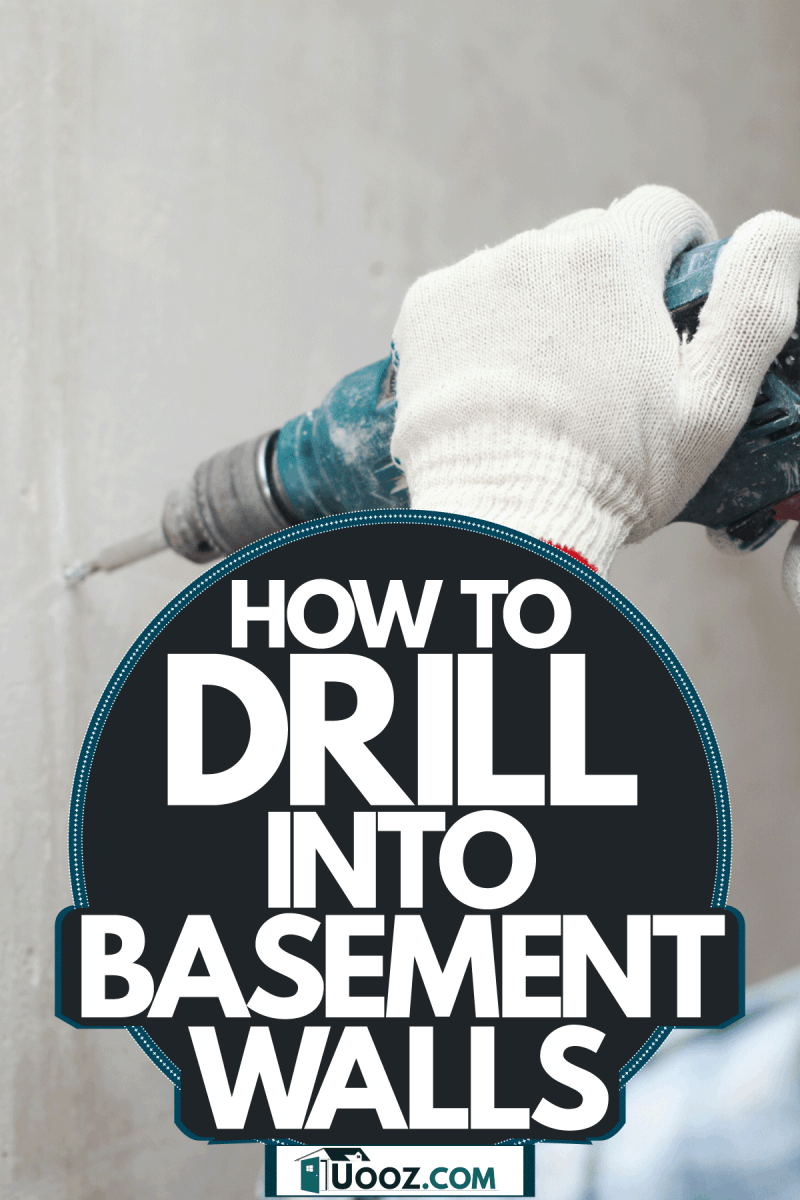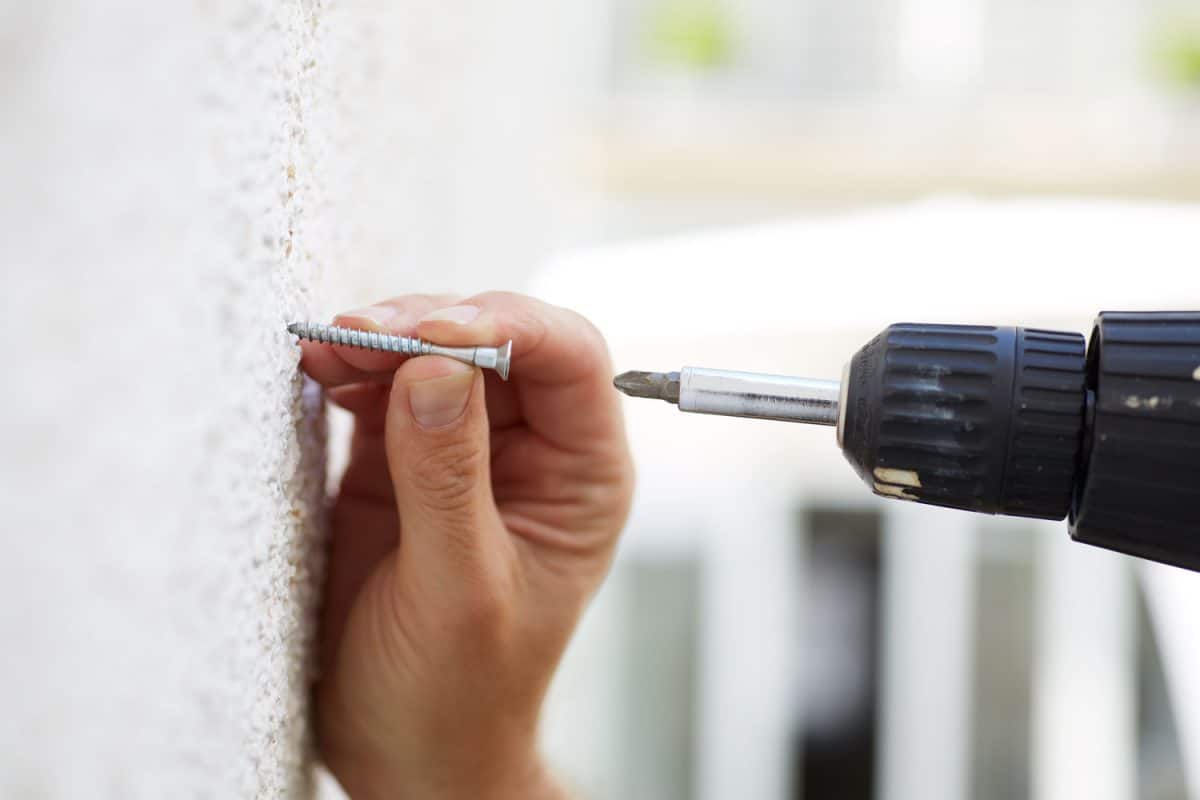Finished basements are a great addition to any home. When it all comes together, you'll have the flooring down, furniture moved in, and walls painted. Now you might find yourself looking at all your wall hangings and question how to drill into the basement walls. We've done the leg work for you to find out!
There are five steps that you should use as your guideline:
- Mark the surface where the nail will go
- Prepare your tools and yourself
- Begin with a light guide hole
- Drill the complete hole
- Add anchors where needed
Your basement walls are an important feature of your home foundation system, and putting holes into it should be done with care. You'll need to use specific drills and bits to make it through the wall to lessen the chance of cracks. In this article, we'll also go into how to hang objects on the wall without needing to make holes. Let's dive in!

Drilling into basement walls
Let us start with tools. It'll be easier and more convenient for you to have a side table ready with all the tools laid out beforehand. Some tools you may have in your home already; others may require a trip to your local hardware store. No matter which method you chose to go with, remember to always take your time during the process.
Tools needed:
- Hammer drill
- Masonry screws
- Carbide mason bit
- Pencil or marker
- Vacuum
- Masking tape (optional)
- Protective gear (gloves, eye protection, dust mask)
- Anchors
- Hammer
1. Mark the surface where the nail will go
This part of the process might be easier to have a helping hand. This way, you'll be able to have someone hang up the object at different heights and spots to determine where you'd like it to go. Once you've decided, use a pencil or marker to mark the spot.
You'll be using this mark as your starting point for the guide holes. Makes sure the mark is dark enough so you can leave and still see it when you come back. There's nothing worse than losing your spot! This will also help you find out on your blueprints what you're marking near.
One of the most important steps in drillings holes into concrete walls is that nothing is behind where you want to make the hole. If you can acquire the blueprints of your home, it will help tremendously. You'll be able to easily avoid water pipes, wiring, and anything else put behind the walls.
2. Prepare your tools and yourself
Having your tools laid out near you will save you the trouble of walking back and forth to your toolbox and digging through it. This will also be an easy way to double-check that you have all the materials needed before starting. Use a side table of some sort and lay everything out.
Depending on what weight limit screws you purchased, the thickness can vary. You'll need to ensure that your drill bit is the correct size needed to work with the screws. The drill bit length is recommended to be 1/4 longer than the desired depth of the hole.
Click here to view this drill bit set on Amazon.
Finally, time to prepare yourself! A lot of dust and small pieces of the wall can come loose when drilling into the concrete. Protect your eyes with goggles, wear gloves to keep fingertips from getting scratched, and wear a dust mask to avoid breathing in the dust. Check to make sure your surroundings are clear from debris or any other tripping hazards.
Click here to view anti-fog, polycarbonate safety goggles on Amazon.
3. Begin with a light guide hole
As you move into the drilling stage, keep yourself steady with your feet grounded and have a firm grip on the drill. Keep the drill perpendicular angle when put against the pre-made mark. Start with the slowest speed and pressure! Adding too much pressure too quickly is a sure way to creating cracks.
Continue with light pressure until you've reached about 1/4 to 1/2 inch into the wall. If your drill doesn't have a built-in depth stopped, use a piece of masking tape to mark the measurement out on the bit. Reverse the drill out and vacuum out the dust from the hole.
4. Drill the complete hole
Starting back again with the now dust-free hole, move onto a medium speed with slightly more pressure to finish the hole to the desired depth. Repeat the cleaning process. Then take your concrete screw and insert it. It should have a secure hold in the hole but should not have to be forced in. A too-small hole with too big of a screw will create too much pressure and lead to cracks.
Click here to view these concrete screws on Amazon.
5. Add anchors where needed
Wall anchors are handy when extra strength is needed and maybe to help fix a "whoops" moment. If you've never drilled into a wall before, it can be easy to accidentally drill too long and make the hole smooth. A smooth wall hole won't have enough surface tension to grip the screw safely.
In the existing hole, gently hammer in the correct sized anchor for the sized screws you have. Then you can add in the concrete screw, like normal. Be careful hammering in the anchor. Once they bend, they cannot be used again. Also, if the drilled hole is too big, an anchor will not be able to make up for the extra space.
Click here to view these wall anchors on Amazon.
Is it safe to drill into a foundation wall?
When the correct technique and procedures are followed, it is safe and common to drill into a foundation wall. Drilling regularly sized holes to hang photos, clocks, and medium-sized pieces of artwork won't put an excessive amount of weight onto the walls. However, if you're looking to make oversized holes into the wall, it's recommended to consult with a structural engineer first.
It should be noted for you to know what is behind your walls. If there is any sort of rebar, it can quickly wear down drill bits and be difficult to drill through. Also, and most importantly, are there any wires or types of piping behind where you're trying to drill? You don't want to start drilling only to be greeted by water.

Will drilling into the concrete crack it?
Drilling too quickly or with too much pressure can crack a concrete wall. Using the correct sized drill bit and screw, light pressure, and patience, you won't have to worry about cracks. It also helps to keep your holes in straight lines to keep the overall internal pressure even.
What's the best drill for concrete walls?
Cordless
This 18-volt drill weighs just under five pounds and is battery-powered. You'll receive 1,200 inches per pound of torque along with the power state brushless motor. Milwaukee is a household name and is a popular choice for homeowners. A great feature of Milwaukee is finding additional accessories such as a side handle or belt clip for it.
Click here to view this Milwaukee Drill on Amazon.
Corded
Corded drills mean you never have to worry about whether or not the battery is charged and can get right to work. Coming in two pounds heavier at seven pounds, you'll be receiving a three-mode operation drill with rotation only, hammering with rotation or chipping. This Makita also comes with a depth stop attached.
Click here to view this Makita Drill on Amazon.
How do you hang things on a concrete basement wall?
To hang things on concrete basement walls, you can use concrete screws or nails from a nail gun. Concrete screws are great for holding heavier objects and can actually be used to hold floating shelves. With the addition of floating shelves, you can add more onto that surface instead of creating more holes for smaller objects.
Nails from air-compressed nail guns will have enough even pressure and strength to pierce concrete walls. These won't go as deep as drilling a hole, so it's best to use these to hang lite weight objects such as small picture frames. As for not drilling holes into the walls, you can hang objects from the ceiling joists.
Using wires and hooks to hang picture frames or art from the ceiling can often be seen in smaller art galleries that have unordinary wall surfaces. With the help of another person, attach a hook to one end of the wire and place the object onto the hook. Then have someone climb a ladder with the wire to figure out how from the wall to place it. Make a mark with a pencil and install the fastener.
Do Command Strips work on concrete walls?
From the Command brand's website, their strips can hang on painted cinder block, wood, plaster, and metal. However, they are not meant for rough surfaces such as cement boards.
Click here to view large utility hook Command Strips on Amazon.
A trick to test out would be to clean the attachment site with rubbing alcohol and then add some adhesive to the command strip for better grip. If you'd like to give this a go, test it out with an object that doesn't contain glass.
All in all
Concrete basement walls can be drilled into by following these five steps: mark the surface, prepare your tools, create a guide hole, drill the full hole, add wall anchors if needed. This project will require some time and patience since you could create cracks from too much pressure and speed. Drilling holes into concrete walls is a relatively simple process but may take a few tries!
Head over to these related posts before you go:







